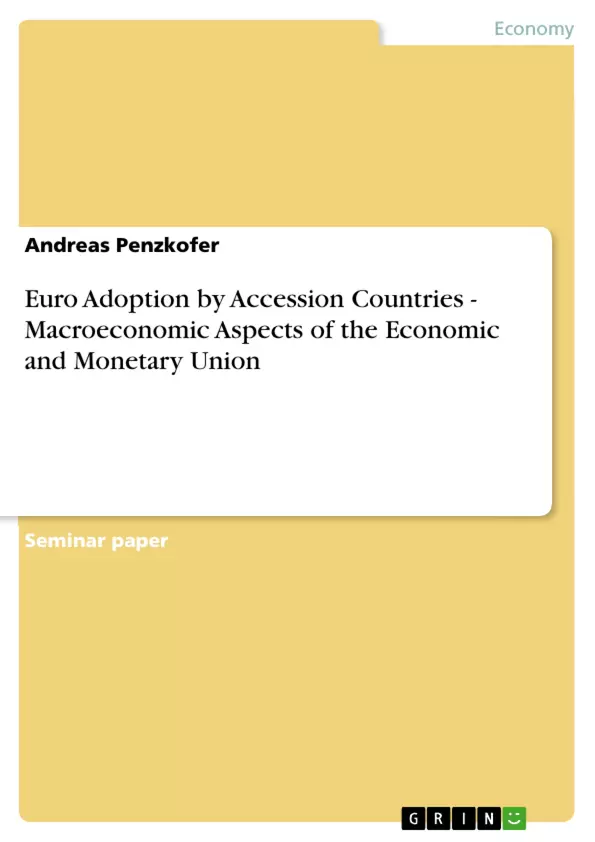On 1st May 2004 ten new member states joined the European Union (EU), e.g. Estonia, Poland and Slovenia. The countries won’t adopt the euro as their new currency immediately, because they first have to show that their economies have converged with the economy of the euro zone.
Presently, the efforts and opinions of the new members differ about the adoption of the single currency. For instance, the Slovenian Prime Minister Janez Jansa told the press in February 2006 that there “is nothing on the path ahead” that could endanger the euro adoption in 2007. The government pursues a tight fiscal policy to meet all entry requirements. Recently, it introduced a dual pricing – that means all prices of goods and services are marked in tolars as well as euros – to raise consumer awareness in the preparation for the euro adoption.1 Contrarily, other countries are skeptical. The leader of the Polish conservative party Jaroslaw Kaczynski said during a campaign that he “doesn’t see any benefits in adopting the euro. Euro adoption would lead to lower exports, lower national income and higher unemployment.” The Estonian Sirje Karu said in an interview, that “Estonians are scared. We heard that when Finland adopted the euro, it took them quite a while to get used to it and prices increased. The poorest suffered.”
Using this situation as a background, it is interesting to analyze the euro adoption by accession states. How does the adoption process work? When should the euro be introduced and what macroeconomic effects does it have?
Inhaltsverzeichnis (Table of Contents)
- Introduction
- Disagreement in the New EU Member States
- Goals and Approach of This Study
- Definition of Key Terms
- Fundamentals of the Euro Adoption by Accession Countries
- History of the Euro
- Enlargement of the EU
- Economic and Monetary Union
- Accession Countries in the Third Stage of Economic and Monetary Union
- Convergence Criteria
- Current Strategies for Euro Adoption
- Fulfillment of the Convergence Criteria
- Directly vs. Steady Euro Adoption
- Balassa-Samuelson Effect
- Completion of the Third Stage of the EMU and its Macroeconomic Effects
- Is the Enlarged EU an Optimum Currency Area?
- Expected Macroeconomic Effects of the Single Currency
- Exchange Rate Risk
- Financial Markets
- Price Parity
- Macroeconomic Stability
- Less-specific Monetary Policy
- The Euro Area In the World Economy
- Conclusion
Zielsetzung und Themenschwerpunkte (Objectives and Key Themes)
The main objective of this research paper is to examine the process of Euro Adoption in the new EU member states and analyze the effects of the introduction of a single currency on their economies. The study aims to provide a comprehensive overview of the economic and monetary aspects of the Eurozone expansion, highlighting the challenges and opportunities associated with adopting the euro.
- The convergence criteria and the process of meeting them by the accession countries
- The economic and political implications of adopting the Euro for the new member states
- The potential macroeconomic effects of a single currency, such as price stability, exchange rate risk, and financial market integration
- The impact of Euro adoption on the overall stability of the Eurozone and its position in the global economy
- The potential challenges and opportunities presented by the Euro adoption process for both the new member states and the existing Eurozone members
Zusammenfassung der Kapitel (Chapter Summaries)
- Introduction: The chapter introduces the context of the study, highlighting the different perspectives on Euro adoption among the new EU member states. It also outlines the goals and approach of the research, focusing on analyzing the Euro adoption process and its macroeconomic effects.
- Fundamentals of the Euro Adoption by Accession Countries: This chapter provides a background on the history of the Euro, the enlargement of the EU, and the process of Economic and Monetary Union (EMU). It discusses the different stages of EMU and the requirements for adopting the Euro.
- Accession Countries in the Third Stage of Economic and Monetary Union: This chapter delves deeper into the convergence criteria for Euro adoption and examines the strategies employed by the accession countries to meet these criteria. It also analyzes the differences between direct and gradual Euro adoption and explores the impact of the Balassa-Samuelson effect on the accession countries.
- Completion of the Third Stage of the EMU and its Macroeconomic Effects: This chapter focuses on the potential macroeconomic effects of the single currency, including the impact on exchange rate risk, financial markets, price parity, macroeconomic stability, and monetary policy. It also discusses the implications of the Eurozone expansion for the global economy.
Schlüsselwörter (Keywords)
This research paper focuses on the macroeconomics of Euro adoption by accession countries. Key terms and concepts include: Euro adoption, Economic and Monetary Union (EMU), convergence criteria, accession countries, macroeconomic effects, exchange rate risk, financial market integration, price parity, macroeconomic stability, and the Eurozone's role in the global economy.
- Arbeit zitieren
- Andreas Penzkofer (Autor:in), 2006, Euro Adoption by Accession Countries - Macroeconomic Aspects of the Economic and Monetary Union, München, GRIN Verlag, https://www.grin.com/document/67267



